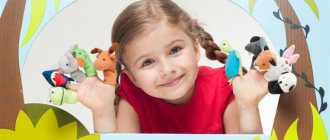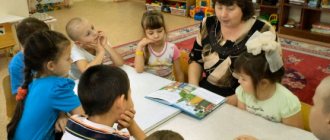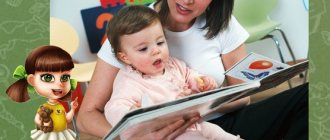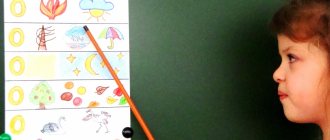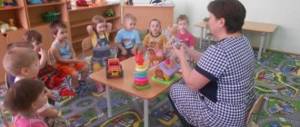“The role of fiction in the development of children’s speech” consultation
“The role of fiction in the development of children’s speech”
The impact of fiction on the mental and aesthetic development of a child is well known. Its role is also great in the development of speech in preschoolers. The importance of introducing children to the beauty of their native word and developing a culture of speech was pointed out by teachers, psychologists, and linguists (K.D. Ushinsky, E.I. Tikheeva, E.A. Flerina, L.S. Vygotsky, S.A. Rubinshtein, F. A. Sokhin, A. V. Zaporozhets, A. M. Shah, L. I. Aidarov and others).
Fiction opens and explains to a child the life of society and nature, the world of human feelings and relationships. It develops the child’s thinking and imagination, generalizes his emotions, provides excellent examples of the Russian literary language, and develops the ability to subtly feel the form and rhythm of his native language.
Fiction accompanies a person from the first years of his life.
Acquaintance with fiction is carried out with the help of literary works of different genres. It is necessary not only to teach children to listen to fairy tales, stories, poems, to draw children’s attention not only to the content of a literary work, but also to some features of the literary language (figurative words and expressions, some epithets and comparisons).
After telling fairy tales, it is necessary to teach preschool children to answer questions related to the content, as well as the simplest questions about the artistic form of the work.
Daily reading of children's literature in kindergarten and special classes in fiction have a great influence on the development of children's vocabulary. Using literary material, children begin to learn complex concepts (genre, rhyme, writer, epithet, etc.). Children not only practice their ability to highlight comparisons in works of art, but also participate in the construction of phrases and sentences with comparisons. At the same time, they learn to use characteristic conjunctions for comparison as, as if, as if.
With the help of fiction, children should develop the ability to notice the beauty and richness of the Russian language. Science and practice have established that if a certain level of language acquisition is not achieved in preschool age, then this path, as a rule, cannot be followed at later stages.
In the current modern conditions, the book has almost lost its former meaning among parents, and television is actively displacing it from children’s lives.
Primary school teachers note that students do not really like poetry and have little interest in fiction. They believe that explanations for this should be sought in kindergarten.
Familiarizing preschool children with children's fiction will contribute to the development of different aspects of children's speech under the following conditions:
• correct selection of fiction in accordance with the age and interests of the child.
• targeted use of fiction in various types of activities.
• with proper organization of joint work with parents.
Principles for selecting literary works for
reading and telling stories to children.
The problem of selecting literary works for children's reading is one of the most important and complex problems of pedagogy. There have long been and are still ongoing debates about what is preferable to read to children and how to determine the range of children's reading: what topics and genres should occupy a dominant position, what is the specific influence of a children's book on the child's personality; is psychologism acceptable in a children's book; how many literary works should a child learn during preschool age; what constitutes children's “readiness”, what should be included in the compulsory reading of a child - a preschooler, etc.
A thoughtful selection of books for children’s reading is determined by what inevitably influences the child’s literary development, the formation of literary experience at the stage of preschool childhood, and the development of an attitude towards books. An interest in books that arose in the early years helps the child in
later, when he masters independent reading, he overcomes all difficulties in order to experience the joy of discovering something new.
The motivating power of children's books is well known. The child strives to imitate the heroes he likes. The plots of literary works are translated into children's games. By living the lives of their favorite characters in the game, children become familiar with their spiritual and moral experience. This once again confirms that through the correct selection of books, one can have a beneficial effect on the moral development of a child’s personality, on the formation of his spiritual values.
A good children's book introduces the child to the world of artistic images, gives the first and therefore the strongest impressions and therefore the strongest impressions of beauty. The specificity of literature is that the means of expressing artistic content is a unique linguistic image, to which the child is drawn unconsciously, attracted by its beauty and unusualness. This encourages the child to repeatedly repeat a bright, living word, to play with words, as a result of which the latter becomes an asset. The book improves the content of the child’s speech, enriches and polishes its form.
Children's literature today is rich in composition and content. In our country, oral works of people from different countries are published for children; works of Russian and foreign classics; children's books by modern domestic and foreign authors. It is impossible to fully embrace all this wealth. The guiding threads are those developed in
In pedagogical science, principles that help to avoid subjectivity allow us to give an objective assessment of books in terms of their content and artistic merit.
What are these principles?
Conventionally, they can be divided into two groups. The first group includes principles that make it possible to correctly evaluate the merits of children's books, to introduce works of different types into the reading circle of preschoolers,
genres, themes. The second group consists of pedagogical principles that make it possible to establish a correspondence between specific literary works and the age-related capabilities of children and select books in such a way that the child, by reading them, seems to rise up the stages of literary development.
Children's literature is art. As an art, it is characterized by the expression of generalized ideas in a bright, artistic form ─ in specific images. Therefore, the artistic level of a literary work is of utmost importance.
The measure of artistry is the organic fusion of the content and ideas of a work with a form of their expression that most closely matches the idea and expresses it in the best possible way. The bearer of ideas in a children's book is always the hero. Concreteness, brightness, and psychological authenticity of characters, events, details, relationships, and experiences make the ideas contained in a literary work accessible, vital, and personally experienced. They are accepted or rejected by the child, depending on how the child treats the hero-exponent of the ideological plan.
Therefore, when selecting literary works, it is necessary first of all to see what positive concept the author puts forward. The ideological orientation of a children's book must meet the objectives of moral education. The book is designed to reveal to the child in concrete images the ideals of justice, kindness, honesty, courage, compassion; to form the correct attitude towards people, towards oneself, towards one’s rights and responsibilities, actions, towards work, towards nature, etc. The best literary works created for children, without excessive didacticism, form in the child a moral attitude towards reality, carry a whole program of positive forms behaviors in which this attitude is manifested and expressed.
Addressing children, writers give them a system of moral guidelines in a complex, diverse world (L.N. Tolstoy. “Kitten”, “Filippok”; K. Chukovsky “Moidodyr”; S. Marshak “The Story of an Unknown Hero”; A .Barto “Toys”, etc.).
Classical literature is also the carrier of the spiritual culture of the people. Reading to a child the works of A.S. Pushkin, N.A. Nekrasov, L.N. Tolstoy, A.P. Chekhov, M.M. Prishvin and other Russian writers is a prerequisite for his spiritual development.
K. D. Ushinsky emphasized that the literature with which a child first encounters should introduce him “to the world of folk thought, folk feeling, folk life, into the realm of the folk spirit.” Such literature, which introduces a child to the spiritual life of his people, is, first of all, works of oral folk art in all its diversity: nursery rhymes, nursery rhymes, riddles, counting books, shifters, proverbs, sayings, tongue twisters, fairy tales, etc. Works of folklore in their content and form are in the best possible way meet the tasks of child upbringing and development, adapted to children's needs. They introduce the child to the element of the folk word, revealing its richness and beauty.
Folklore forms in a child a sense of belonging to his people, his culture, and a sense of his native language. Works of Russian folklore, starting with lullabies, nursery rhymes and ending with fairy tales and proverbs, give children lessons for life: lessons of physical and moral cleanliness (the nursery rhyme “Water, water...”, fairy tales “The Frog Princess”), hard work, kindness (“ Khavroshechka”, “Sister Alyonushka and brother Ivanushka”, etc.), friendship, warmth in relationships, mutual assistance (“Turnip>>, “The Fox and the Hare”, “Cat, Rooster and Fox”, etc.). All lullabies, nurseries, and nursery rhymes are permeated with warmth and love.
Children's reading also includes folklore of the peoples of the world and works of foreign writers for children. They carry the great potential of national and folk cultures, making the child the owner of universal spiritual values.
Thus, in his literary development, a child must move from the literature of his people to the classics of world children's literature. At the same time, children's reading should include books of a variety of topics and genres. This will allow, on the one hand, to develop a breadth of reading interests in preschoolers, and, on the other, selectivity and individuality of literary preferences.
Modern children's literature satisfies the various interests and needs of the child: the need for the fantastic and heroic, adventure, educational and humorous, etc.
A passion for poetry is a distinctive feature of a preschooler reader. K.I. Chukovsky considered every person from 2 to 5 a poet: never in other years has a child been so attached to poetry, so demanding of poetry and not preferring it to prose. K.I. Chukovsky noted the child’s readiness to jump, gallop, and easily remember and shout the poems he liked, characteristic of this age. Therefore, K.I. himself preferred to write in poetry for children. Chukovsky, and S. Ya. Marshak, A.L. Barto, and many other masters of artistic expression.
The literary preferences of preschool children also include folk and original fairy tales by domestic and foreign writers A.M. Gorky, A.N. Tolstoy, Yu. K. Olesha, K.I. Chukovsky, E.N. Uspensky, B.V. Zakhoder, I.P. Tokmakova, J. Rodari, A. Lindgren, T. Janson, A. Milna and others. A fairy tale arouses love and lasting interest in all preschoolers with its dynamism, brightness of images, unusualness, mystery, entertaining events, unlimited possibilities for fantasy, invention, and play. mind.
The principle of genre and thematic diversity of books allows children to reveal the versatility of the world in which they live and to develop an interest in the affairs of different people. Thus, educational books about work, about things, about technology, about nature have become an integral part of children's literature. They are interesting to the modern child because in a figurative form they show him the essence of phenomena, shape his thinking, teach him to take care of things created by human labor, to love and protect the surrounding nature.
An integral part of the inner world of a modern person is humor, which helps to build relationships and live in harmony with oneself and the people around you. Children's literature has created a special type of book ─ a cheerful book for children. A cheerful book meets the child's needs for joy, spiritual optimism, and confidence that the world around him is harmonious. She reveals to children the funny things in life, develops valuable qualities ─ the ability to joke and laugh, and accept life with all its good and bad sides with a sense of humor. The works of K.I. Chukovsky, N.N. Nosov, V.G. Suteev, V.Yu. Dragunsky, E.N. Uspensky and others are always loved by children.
In addition, the genre and thematic diversity of children's literature makes it possible to form individual reading interests and inclinations in children. Some children love books about animals, others like to hear about adventures, and still others prefer stories about the lives of their peers. It is necessary to know about the child’s emerging literary inclinations in order to develop them.
The principles of selecting books for children's reading will play a positive role if the works of art intended for reading are accessible to the child's understanding. In this regard, the principle of accessibility takes on special significance.
A literary work can be considered accessible only when the author, taking into account the life experience of the child ─ the reader, simultaneously sets tasks that require mental effort from him and thereby raise the child to a new level of emotional and mental development.
Selecting the best is the task of the teacher.
"Development of children's speech through fiction"
Preparation for the lesson includes the following points:
· a reasonable choice of work in accordance with developed criteria (artistic level and educational value), taking into account the age of the children, current educational work with children and the time of year, as well as the choice of methods for working with the book;
determination of program content - literary and educational tasks;
· preparing the teacher for reading the work. It is necessary to read the work so that children understand the main content, idea and emotionally experience what they listen to (feel it).
The preliminary work also includes preparing the children. First of all, preparation for the perception of a literary text, for understanding its content and form.
Explanation of unfamiliar words
– a mandatory technique that ensures a full perception of the work. It is necessary to explain the meanings of those words, without understanding which the main meaning of the text, the nature of the images, and the actions of the characters become unclear. The explanation options are different: substituting another word while reading prose, selecting synonyms, using words or phrases by the teacher before reading.
The methodology for conducting a lesson in artistic reading and storytelling and its structure depend on the type of lesson, the content of the literary material and the age of the children. The structure of a typical lesson can be divided into three parts. In the first part, an introduction to the work takes place; the main goal is to provide children with a correct and vivid perception through artistic expression. In the second part, a conversation is held about what has been read, in order to clarify the content, literary and artistic form, and means of artistic expression. In the third part, repeated reading of the text is organized in order to consolidate the emotional impression and deepen the perception.
When introducing preschoolers to fiction, various methods are used to form a full perception of the work by children: expressive reading by the teacher, conversation about what they read, repeated reading, looking at illustrations, explaining unfamiliar words.
A special place in children's reading is occupied by such a genre as a story for little ones. Reading such a book becomes especially exciting for children if the most interesting chapters are read repeatedly. It is important to correctly divide the work into parts. Each part must be complete. You can't stop at the most interesting place.
Reading books with moral content is of great importance. Through artistic images, they develop courage, a sense of pride and admiration for the heroism of people, empathy, responsiveness, and a caring attitude towards loved ones.
The role of fiction in the speech development of children
Tatyana Sigitova
The role of fiction in the speech development of children
The role of fiction in the speech development of children (from work experience)
Speech is beautiful when it is like a stream,
Runs among the stones - clean, leisurely,
And you are ready to listen to its flow and exclaim:
“Oh, how beautiful you are!”
.
Fiction accompanies a person from the first years of his life.
The impact of fiction on the mental and aesthetic development of a child . Fiction plays a huge .
The importance of introducing children to the beauty of their native word and developing a culture of speech was pointed out by teachers, psychologists, and linguists (K. D. Ushinsky, E. I. Tikheyeva, E. A. Flerina, L. S. Vygotsky, S. A. Rubinshtein, F. A. Sokhin, A. V. Zaporozhets, etc.).
E. A. Flerina noted that a literary work provides ready-made linguistic forms, verbal characteristics of the image, definitions with which the child operates. By means of artistic expression, even before school , before mastering grammatical rules, a small child practically masters the grammatical norms of the language in unity with its vocabulary.
L. S. Vygotsky said that “A child who is systematically read to accumulates a rich vocabulary, as he hears more words that are different in their orientation. By reading with his mother, the baby not only learns something new, but also actively develops speech , verbal creativity , imagination and memory, and sometimes learns important life lessons.”
Children's books are considered as a means of mental, moral and aesthetic education.
Children's poet I. Tokmakova calls children's literature the fundamental basis of education.
Works of literature contribute to the development of speech and provide examples of the Russian literary language .
From the book, the child learns many new words and figurative expressions, his speech is enriched with emotional and poetic vocabulary. Literature helps children express their attitude to what they have heard, using comparisons, metaphors, epithets and other means of figurative expression.
speech and aesthetic development clearly appears ; language is assimilated in its aesthetic function. Mastery of linguistic figurative and expressive means serves to develop artistic perception of literary works .
The educational function of literature is carried out in a special way, inherent only to art - by the force of influence of the artistic image . In order to fully realize the educational potential of literature , it is necessary to know the psychological characteristics of the perception and understanding of this type of art by preschoolers.
The formation of verbal communication in the process of becoming familiar with works of fiction begins with emotional communication. It is the core, the main content of the relationship between an adult and a child during the preparatory period of speech development . He seems to become infected with the emotional state of the work. Lives the life of heroes, learns new vocabulary, and expands the content of his active vocabulary. This is emotional communication, not verbal , but it lays the foundations for future speech, future communication with the help of meaningfully pronounced words.
System of specific pedagogical actions, content, methods, techniques of education and training
My personal observations show that children who have good command of their speech feel more comfortable in a group, they more often become the center of attention of their peers, as they can share their impressions of what they saw, tell something interesting, and communicate more easily with adults.
Children with expressive speech and clear diction often perform at matinees: they read poetry and participate in mini-skits. The rest of the children remain only passive observers and listeners. such children in the group .
I believe that every child should express themselves, express their thoughts, share their knowledge and feelings. I have set a goal for myself: to develop coherent and expressive speech in children .
To achieve the goal, I identified the following tasks:
• Develop an interest in fiction .
children's vocabulary .
• To introduce the main genre features of fairy tales, stories, and poems.
• Improve children's artistic and speech performing skills when reading poems and dramatizations.
• Draw children's to visual and expressive means; help to feel the beauty and expressiveness of the language of the work, instill sensitivity to the poetic word.
• Develop creativity in children .
Building a system of work on the development of speech of preschoolers , I determined the main areas of activity:
• creation of a speech development environment ;
• work with children; working with parents;
• work with society (city children's library, city museum, municipal theater, etc.).
From the book, the child learns many new words and figurative expressions, his speech is enriched with emotional and poetic vocabulary. Literature helps children express their attitude to what they have heard, using comparisons, metaphors, epithets and other means of figurative expression.
When familiarizing yourself with fiction speech and aesthetic development clearly appears ; language is assimilated in its aesthetic function.
When selecting books, I took into account that a literary work should have cognitive, aesthetic and moral functions. The demands of modern life and pedagogical science force us to constantly reconsider the range of children's reading, supplementing it with new works. I pay special attention to the development of children’s figurative speech in the process of familiarizing themselves with various genres of literature (fairy tale, short story, poem, fable)
and small folklore forms.
There are certain methods of familiarizing yourself with fiction :
1. Reading by the teacher from a book or by heart, i.e. verbatim transmission of the text.
2. Narration by the teacher, i.e. free transmission of the text.
3. Dramatization. This method can be considered as a means of secondary familiarization with works of art .
4. Learning by heart.
Reading and storytelling using visual material includes:
- reading, storytelling with toys (repetition of telling the fairy tale “Kolobok”
accompanied by a display of toys and actions with them);
— table theater;
- puppet and shadow, flannelgraph;
- filmstrip, transparencies, TV shows.
Fiction is an important source and means of developing all aspects of children's speech . Various genres of literature and folklore works lay the foundation for the formation of love for the native language, its accuracy and expressiveness, accuracy and imagery. The development of a child’s figurative speech is carried out in unity with the development of aspects of speech : phonemic, lexical, grammatical. Speech becomes figurative and lively if the child develops an interest in linguistic richness and develops the ability to use a wide variety of expressive means in his speech. It is very important to draw the child’s attention to the figurative language of fairy tales, short stories, poetry, works of oral folk art, including small folklore forms: proverbs, riddles, nursery rhymes, songs, counting rhymes, phraseological units.
The development of all aspects of speech has a great influence on the development of independent verbal creativity, which can manifest itself in a child in a wide variety of genres - writing fairy tales, stories, poems, nursery rhymes, riddles.
I constantly use these folklore works when dressing, feeding, washing, going to bed, in play activities and in the process of communicating with nature. Folk nursery rhymes, jokes, and chants provide excellent speech material , which I use in classes on development and in joint activities with children. Nursery rhymes are built on many repetitions; individual words, phrases, sentences and even quatrains are repeated. Children remember quatrains and actively use them in everyday life.
When working with children, I pay a lot of attention to riddles; they are an important technique in all types of activities. Guessing and inventing riddles has an impact on the diversified development of children's speech . Riddles use various means of expressiveness (epithets, comparisons, definitions, which contributes to the formation of a child’s figurative speech. Riddles enrich children’s due to the polysemy of words, help to see the secondary meaning of words, and form ideas about the figurative meaning of a word.
The child likes cheerful and funny poems; word games help children master their native language perfectly. The child’s speech is enriched with words and expressions he remembers, phonemic hearing develops , and attention to grammatical lexical norms becomes more acute. Changelings, confusions, and fables help us with this.
An important place is given to teaching children to understand the figurative content and general meaning of proverbs and sayings. K. D. Ushinsky called proverbs and sayings an excellent means of developing figurative speech . Proverbs and sayings are folk wisdom, a set of rules of life. They are poetic, the idea is expressed in them laconically, sharply, completely. In addition to the direct meaning, folk sayings also have a figurative meaning.
's most favorite genre in fiction is the fairy tale .
Forms of work: reading, discussion, learning.
In addition to them, it is necessary to use such forms of organizing and conducting classes as: conversations, travel through fairy tales, observations, excursions to the library, exhibitions of drawings, competitions, entertainment , theatrical games.
Methods used in the work: visual, verbal, practical.
Such techniques allow you to remember good books, awaken thoughts, and develop children’s creative imagination .
When organizing work on the development of speech in preschoolers , she identified the main areas of activity:
• creation of a speech development environment ;
• work with children; working with parents;
• Creation of a subject-development environment .
In the group, she created a subject-development environment in the form of a book corner, which included albums with images of domestic and foreign writers; in the theater corner, different types of theaters were updated to dramatize and improve speech and performing skills in children . It is necessary to select didactic games that enrich and activate the vocabulary: “Journey”, “Rhyme”, “Who is hiding and where”, improving the sound culture of speech (“Sound Domino”, “Find the sound”, “Who is screaming like that?”, “Listen” sounds of the street”, developing coherent speech , memory, thinking, imagination in preschoolers (“Imagine”, “Tell me which one:”, “Topsy-turvy”, “Talking about polysemantic words”, “Wizard”, “Circus”, “Animals” and their young” , “Poets”, etc.).
